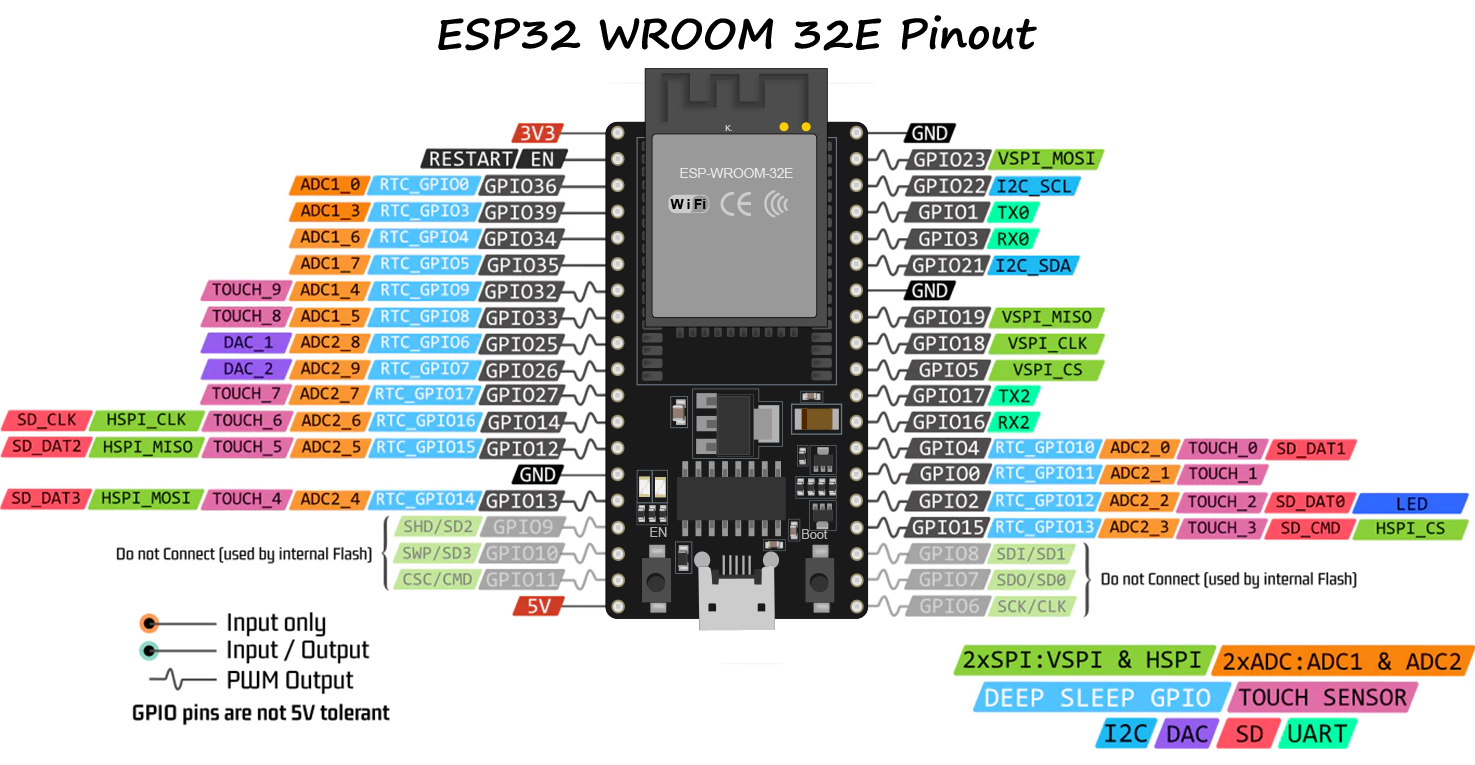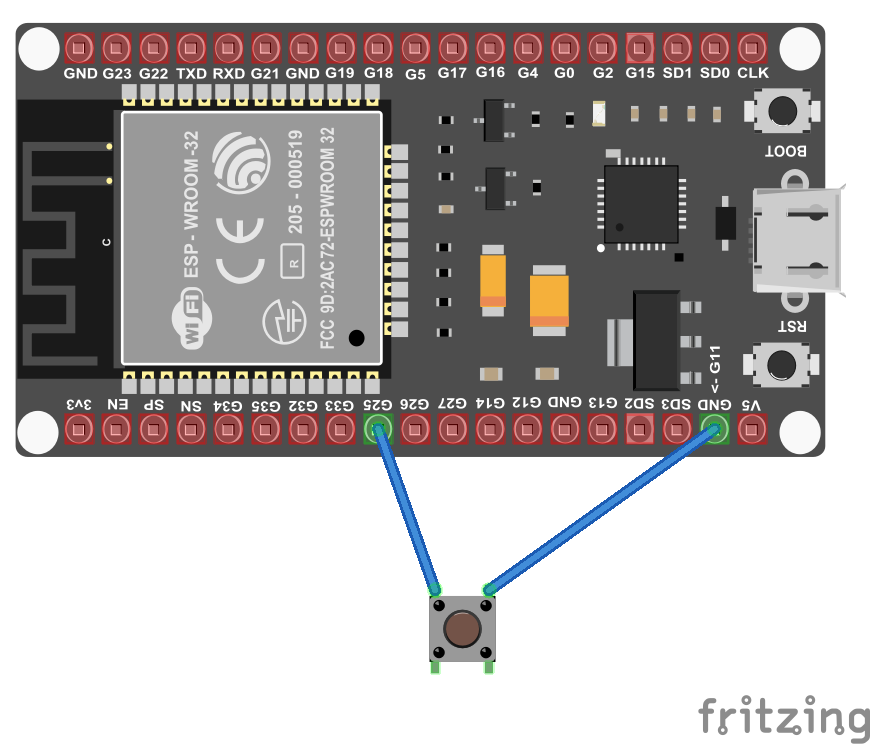.NET nanoFramework 嵌入式学习随笔
硬件: ESP-WROOM-32E


1.闪灯
public class Program { public static void Main() { //单闪 GpioPin led = new GpioController().OpenPin(15, PinMode.Output); led.Write(PinValue.Low); while (true) { led.Toggle(); Thread.Sleep(125); led.Toggle(); Thread.Sleep(125); led.Toggle(); Thread.Sleep(125); led.Toggle(); Thread.Sleep(525); } Thread.Sleep(Timeout.Infinite); } }
2.闪自带蓝灯
public class Program { public static void Main() { //闪蓝光 GpioPin led = new GpioController().OpenPin(2, PinMode.Output); while (true) { // Turn on the LED led.Write(PinValue.High); Thread.Sleep(500); // Turn off the LED led.Write(PinValue.Low); Thread.Sleep(500); } Thread.Sleep(Timeout.Infinite); } }
3.按钮控制灯光
public class Program { public static void Main() { //按钮控制灯光 Debug.WriteLine("Hello from nanoFramework!"); var gpio = new GpioController(); // Setup the GPIO pin to 2 as it is the embedded led in the ESP32 // Open the pin in output mode // If your board has another pin, change here. If you are using an external led, change here as well. GpioPin led = gpio.OpenPin(15, PinMode.Output); // Initialize a new button with the corresponding button pin // You can adjust the pin number based on the pin you are using // As for the simple button sample, it is using pull up by default GpioButton button = new GpioButton(buttonPin: 13); Debug.WriteLine("Button is initialized, starting to read state"); // Enable or disable holding or doublepress events button.IsDoublePressEnabled = true; button.IsHoldingEnabled = true; // Write to debug if the button is down button.ButtonDown += (sender, e) => { Debug.WriteLine($"buttondown IsPressed={button.IsPressed}"); led.Write(PinValue.High); }; // Write to debug if the button is up button.ButtonUp += (sender, e) => { Debug.WriteLine($"buttonup IsPressed={button.IsPressed}"); led.Write(PinValue.Low); }; // Write to debug if the button is pressed button.Press += (sender, e) => { Debug.WriteLine($"Press"); }; // Write to debug if the button is double pressed button.DoublePress += (sender, e) => { Debug.WriteLine($"Double press"); }; // Write to debug if the button is held and released button.Holding += (sender, e) => { switch (e.HoldingState) { case ButtonHoldingState.Started: Debug.WriteLine($"Holding Started"); break; case ButtonHoldingState.Completed: Debug.WriteLine($"Holding Completed"); break; } }; Thread.Sleep(Timeout.Infinite); } }
4. PWM调光
using Iot.Device.Button;
using System;
using System.Device.Gpio;
using System.Device.Pwm;
using System.Diagnostics;
using System.Threading;
using nanoFramework.Hardware.Esp32;
public class Program { public static void Main() { //PWM调光 // Pin 2 is the integrated LED in the ESP32, if you are using another board, change the pin number int pinLed = 2; // If you have an ESP32, you should setup the pin first to be used with PWM: Configuration.SetPinFunction(pinLed, DeviceFunction.PWM1); // Then you can create the PWM Channel from the pin: PwmChannel pwmPin = PwmChannel.CreateFromPin(pinLed, 40000, 0); // Note: even if possible, it is not recommended to adjust the frequency once created. // Start the PWM pwmPin.Start(); // Now, we will loop to increase and decrease the duty cycle while (true) { // We will increase the duty cycle by 1 percent every 20 milliseconds for (int i = 0; i <= 100; i++) { pwmPin.DutyCycle = (double)i / 100; Thread.Sleep(20); } // We will decrease the duty cycle by 1 percent every 20 milliseconds for (int i = 100; i >= 0; i--) { pwmPin.DutyCycle = (double)i / 100; Thread.Sleep(20); } } Thread.Sleep(Timeout.Infinite); } }
5.湿度传感器
AdcController adc1 = new AdcController(); // Get the reference minimul and maximum values int max1 = adc1.MaxValue; int min1 = adc1.MinValue; Debug.WriteLine("min1=" + min1.ToString() + " max1=" + max1.ToString()); // We will use the pin 34 which is already setup as ADC1_CH6 // If you want to change to use another pin, this function needs to be used to setup the pin // Note, that not all configurations are possible. You'll have to refer to the ESP32 Technical Reference Manual // or the board you're using to see which pins can be used as ADC. // Configuration.SetPinFunction(34, DeviceFunction.ADC1_CH6); AdcChannel sensor = adc1.OpenChannel(6); while (true) { // Read the raw value int rawValue = sensor.ReadValue(); // Calculate the voltage // The ESP32 is using 3.3 V as the reference voltage // The ADC has a 12-bit resolution, so the maximum value is 4095 // Still, using the AdcController.MaxValue and MinValue is a good practice double voltage = ((double)(rawValue - min1) / (max1 - min1)) * 3.3; Debug.WriteLine($"Raw Value: {rawValue}, Voltage: {voltage}"); // Here, it's more empirical, you can adjust to your own needs // You can also use directly the raw value to compare if (voltage < 1.5) { Debug.WriteLine("It's wet!"); } else { Debug.WriteLine("It's dry!"); } Thread.Sleep(1000); } Thread.Sleep(Timeout.Infinite);
6.继电器控制,注意供电是5v
public class RelayUtils
{
// 继电器连接的GPIO引脚(可根据实际连接修改)
private const int RELAY_PIN = 2; // GPIO2
// GPIO控制器
private static GpioController gpio;
private static GpioPin relayPin;
// 继电器状态
private static bool relayState = false;
/// <summary>
/// 初始化GPIO
/// </summary>
public static void InitializeGpio()
{
// 创建GPIO控制器
gpio = new GpioController();
// 配置继电器引脚为输出模式
relayPin = gpio.OpenPin(RELAY_PIN, PinMode.Output);
// 初始状态设置为关闭(低电平)
relayPin.Write(PinValue.Low);
relayState = false;
Console.WriteLine("GPIO初始化完成");
}
/// <summary>
/// 打开继电器
/// </summary>
public static void TurnOnRelay()
{
if (relayPin != null)
{
relayPin.Write(PinValue.High);
relayState = true;
Console.WriteLine("继电器已打开");
}
}
/// <summary>
/// 关闭继电器
/// </summary>
public static void TurnOffRelay()
{
if (relayPin != null)
{
relayPin.Write(PinValue.Low);
relayState = false;
Console.WriteLine("继电器已关闭");
}
}
/// <summary>
/// 切换继电器状态
/// </summary>
public static void ToggleRelay()
{
if (relayState)
{
TurnOffRelay();
}
else
{
TurnOnRelay();
}
}
/// <summary>
/// 获取继电器当前状态
/// </summary>
/// <returns>true为开启,false为关闭</returns>
public static bool GetRelayState()
{
return relayState;
}
/// <summary>
/// 定时控制继电器(开启指定时间后自动关闭)
/// </summary>
/// <param name="durationMs">开启持续时间(毫秒)</param>
public static void TimedRelay(int durationMs)
{
Console.WriteLine($"定时开启继电器 {durationMs}ms");
TurnOnRelay();
Thread.Sleep(durationMs);
TurnOffRelay();
}
/// <summary>
/// 脉冲控制继电器
/// </summary>
/// <param name="pulseCount">脉冲次数</param>
/// <param name="pulseWidth">脉冲宽度(毫秒)</param>
/// <param name="interval">脉冲间隔(毫秒)</param>
public static void PulseRelay(int pulseCount, int pulseWidth, int interval)
{
Console.WriteLine($"脉冲控制: {pulseCount}次, 宽度{pulseWidth}ms, 间隔{interval}ms");
for (int i = 0; i < pulseCount; i++)
{
TurnOnRelay();
Thread.Sleep(pulseWidth);
TurnOffRelay();
if (i < pulseCount - 1) // 最后一次不需要间隔
{
Thread.Sleep(interval);
}
}
}
/// <summary>
/// 清理GPIO资源
/// </summary>
public static void CleanupGpio()
{
try
{
if (relayPin != null)
{
// 关闭继电器
relayPin.Write(PinValue.Low);
relayPin.Dispose();
}
if (gpio != null)
{
gpio.Dispose();
}
Console.WriteLine("GPIO资源已清理");
}
catch (Exception ex)
{
Console.WriteLine($"清理资源时发生异常: {ex.Message}");
}
}
}
7.通过网页控制继电器
using nanoFramework.Networking; using System; using System.Device.Gpio; using System.Diagnostics; using System.Net; using System.Net.NetworkInformation; using System.Text; using System.Threading; namespace ESP32RelayController { public class Program { // WiFi配置 private const string WIFI_SSID = "aaa"; private const string WIFI_PASSWORD = "zqyo850619"; // 服务器配置 private const int SERVER_PORT = 8080; // 继电器引脚配置(根据你的硬件连接修改) private const int RELAY1_PIN = 15; // 继电器1 private const int RELAY2_PIN = 4; // 继电器2 private const int STATUS1_PIN = 17; // 继电器1状态 private const int STATUS2_PIN = 16; // 继电器2状态 // LED指示灯(可选) private const int LED_PIN = 2; private static GpioController _gpio; private static HttpListener _httpListener; public static void Main() { Console.WriteLine("ESP32 远程继电器控制器启动中..."); // 初始化GPIO InitializeGpio(); // 连接WiFi if (ConnectToWiFi()) { Console.WriteLine("WiFi连接成功!"); // 启动HTTP服务器 StartHttpServer(); } else { Console.WriteLine("WiFi连接失败!"); return; } // 主循环 while (true) { Thread.Sleep(1000); // 这里可以添加状态监控代码 } } private static void InitializeGpio() { _gpio = new GpioController(); // 初始化继电器引脚为输出模式,默认关闭(高电平) _gpio.OpenPin(RELAY1_PIN, PinMode.Output); _gpio.OpenPin(RELAY2_PIN, PinMode.Output); _gpio.OpenPin(STATUS1_PIN, PinMode.Input); _gpio.OpenPin(STATUS2_PIN, PinMode.Input); // 继电器默认关闭(假设低电平触发) _gpio.Write(RELAY1_PIN, PinValue.High); _gpio.Write(RELAY2_PIN, PinValue.High); // 初始化LED指示灯 _gpio.OpenPin(LED_PIN, PinMode.Output); _gpio.Write(LED_PIN, PinValue.Low); Console.WriteLine("GPIO初始化完成"); } private static bool ConnectToWiFi() { Console.WriteLine($"正在连接WiFi: {WIFI_SSID}"); // 启用WiFi if (!WifiNetworkHelper.ConnectDhcp(WIFI_SSID, WIFI_PASSWORD, requiresDateTime: true)) { return false; } // 获取网络接口信息 NetworkInterface ni = NetworkInterface.GetAllNetworkInterfaces()[0]; Console.WriteLine($"IP地址: {ni.IPv4Address}"); Console.WriteLine($"网关: {ni.IPv4GatewayAddress}"); Console.WriteLine($"DNS: {ni.IPv4DnsAddresses[0]}"); return true; } private static void StartHttpServer() { _httpListener = new HttpListener("http", SERVER_PORT); _httpListener.Start(); Console.WriteLine($"HTTP服务器已启动,监听端口: {SERVER_PORT}"); // 显示访问地址 NetworkInterface ni = NetworkInterface.GetAllNetworkInterfaces()[0]; Console.WriteLine($"控制地址: http://{ni.IPv4Address}:{SERVER_PORT}/"); // 启动请求处理线程 new Thread(HandleRequests).Start(); } private static void HandleRequests() { while (true) { HttpListenerContext context = null; try { context = _httpListener.GetContext(); ProcessRequest(context); } catch (Exception ex) { Debug.WriteLine($"请求处理异常: {ex.Message}"); } } } private static void ProcessRequest(HttpListenerContext context) { HttpListenerRequest request = context.Request; HttpListenerResponse response = context.Response; string responseString = ""; try { string url = request.RawUrl.ToLower(); Console.WriteLine($"收到请求: {request.HttpMethod} {url}"); if (request.HttpMethod == "GET") { if (url == "/" || url == "/index.html") { // 返回控制界面 responseString = GetControlPageHtml(); response.ContentType = "text/html; charset=utf-8"; } else if (url.StartsWith("/relay/")) { // 处理继电器控制命令 responseString = HandleRelayCommand(url); response.ContentType = "application/json; charset=utf-8"; } else if (url == "/status") { // 返回状态信息 responseString = GetStatusJson(); response.ContentType = "application/json; charset=utf-8"; } else { response.StatusCode = 404; responseString = "页面未找到"; } } else { response.StatusCode = 405; responseString = "方法不支持"; } // 发送响应 byte[] buffer = Encoding.UTF8.GetBytes(responseString); response.ContentLength64 = buffer.Length; response.OutputStream.Write(buffer, 0, buffer.Length); response.OutputStream.Close(); } catch (Exception ex) { // 在nanoFramework中,确保在异常情况下也正确关闭 if (context?.Response != null) { try { response.StatusCode = 500; // responseString = $"服务器错误: {ex.Message}"; Console.WriteLine($"处理请求错误: {ex.Message}"); context.Response.Close(); } catch { // 静默处理关闭异常 } } } finally { // 确保响应被关闭 response?.Close(); } } private static string HandleRelayCommand(string url) { try { // 解析URL: /relay/{relayNumber}/{action} string[] parts = url.Split('/'); if (parts.Length < 4) { return "{\"success\": false, \"message\": \"无效的命令格式\"}"; } int relayNumber = int.Parse(parts[2]); string action = parts[3].ToLower(); if (relayNumber < 1 || relayNumber > 2) { return "{\"success\": false, \"message\": \"继电器编号必须在1-2之间\"}"; } int pin = GetRelayPin(relayNumber); bool success = false; string message = ""; switch (action) { case "on": _gpio.Write(pin, PinValue.Low); // 低电平触发 success = true; message = $"继电器{relayNumber}已开启"; Console.WriteLine(message); break; case "off": _gpio.Write(pin, PinValue.High); // 高电平关闭 success = true; message = $"继电器{relayNumber}已关闭"; Console.WriteLine(message); break; case "toggle": bool currentState = ReadControlPinStatus(pin); PinValue newState = currentState ? PinValue.High : PinValue.Low; _gpio.Write(pin, newState); success = true; message = $"继电器{relayNumber}已切换到{(newState == PinValue.Low ? "开启" : "关闭")}"; Console.WriteLine(message); break; default: message = "无效的操作,支持: on/off/toggle"; break; } return $"{{\"success\": {success.ToString().ToLower()}, \"message\": \"{message}\"}}"; } catch (Exception ex) { return $"{{\"success\": false, \"message\": \"处理命令错误: {ex.Message}\"}}"; } } private static int GetRelayPin(int relayNumber) { switch (relayNumber) { case 1: return RELAY1_PIN; case 2: return RELAY2_PIN; default: throw new ArgumentException("无效的继电器编号"); } } private static string GetStatusJson() { // 读取所有继电器状态 bool relay1 = ReadControlPinStatus(RELAY1_PIN); bool relay2 = ReadControlPinStatus(RELAY2_PIN); return $@"{{ ""relay1"": {relay1.ToString().ToLower()}, ""relay2"": {relay2.ToString().ToLower()}, ""uptime"": {TimeSpan.TicksPerMinute} }}"; } private static bool ReadControlPinStatus(int pin) { if (pin==RELAY1_PIN) { return _gpio.Read(STATUS1_PIN) == PinValue.Low; } return _gpio.Read(STATUS2_PIN) == PinValue.Low; } private static string GetControlPageHtml() { return @"<!DOCTYPE html> <html> <head> <meta charset='utf-8'> <title>ESP32 继电器控制器</title> <meta name='viewport' content='width=device-width, initial-scale=1'> <style> body { font-family: Arial; text-align: center; margin: 20px; } .relay-box { display: inline-block; margin: 10px; padding: 20px; border: 2px solid #333; border-radius: 10px; width: 200px; } .btn { padding: 10px 20px; margin: 5px; font-size: 16px; border: none; border-radius: 5px; cursor: pointer; } .btn-on { background-color: #4CAF50; color: white; } .btn-off { background-color: #f44336; color: white; } .btn-toggle { background-color: #008CBA; color: white; } .status { margin: 10px 0; font-weight: bold; } </style> </head> <body> <h1>ESP32 继电器控制器</h1> <div id='relays'> <div class='relay-box'> <h3>继电器 1</h3> <div class='status' id='status1'>状态: 未知</div> <button class='btn btn-on' onclick='controlRelay(1, ""on"")'>开启</button> <button class='btn btn-off' onclick='controlRelay(1, ""off"")'>关闭</button> <button class='btn btn-toggle' onclick='controlRelay(1, ""toggle"")'>切换</button> </div> <div class='relay-box'> <h3>继电器 2</h3> <div class='status' id='status2'>状态: 未知</div> <button class='btn btn-on' onclick='controlRelay(2, ""on"")'>开启</button> <button class='btn btn-off' onclick='controlRelay(2, ""off"")'>关闭</button> <button class='btn btn-toggle' onclick='controlRelay(2, ""toggle"")'>切换</button> </div> </div> <div style='margin-top: 30px;'> <button class='btn' onclick='refreshStatus()' style='background-color: #555; color: white;'>刷新状态</button> </div> <script> function controlRelay(relayNumber, action) { fetch('/relay/' + relayNumber + '/' + action) .then(response => response.json()) .then(data => { alert(data.message); refreshStatus(); }) .catch(error => { alert('错误: ' + error); }); } function refreshStatus() { fetch('/status') .then(response => response.json()) .then(data => { document.getElementById('status1').textContent = '状态: ' + (data.relay1 ? '开启' : '关闭'); document.getElementById('status2').textContent = '状态: ' + (data.relay2 ? '开启' : '关闭'); }) .catch(error => { console.error('获取状态失败:', error); }); } // 页面加载时刷新状态 window.onload = function() { refreshStatus(); // 每5秒自动刷新状态 setInterval(refreshStatus, 10000); }; </script> </body> </html>"; } } }





 浙公网安备 33010602011771号
浙公网安备 33010602011771号